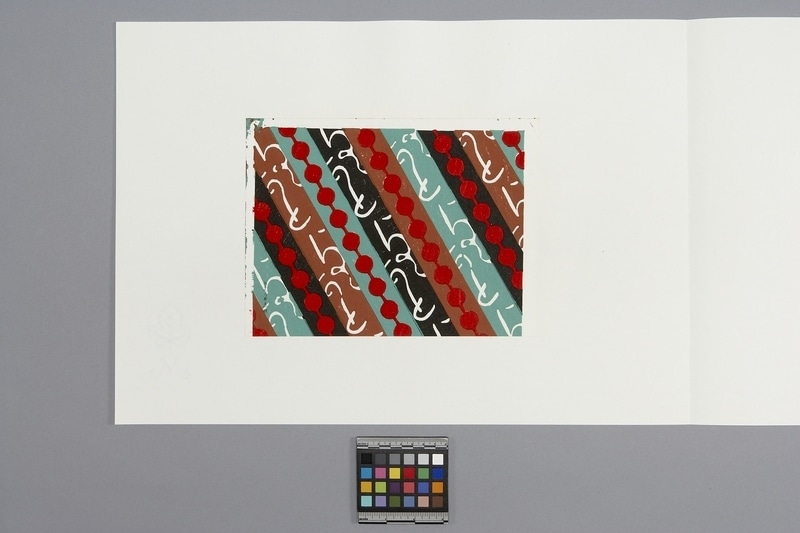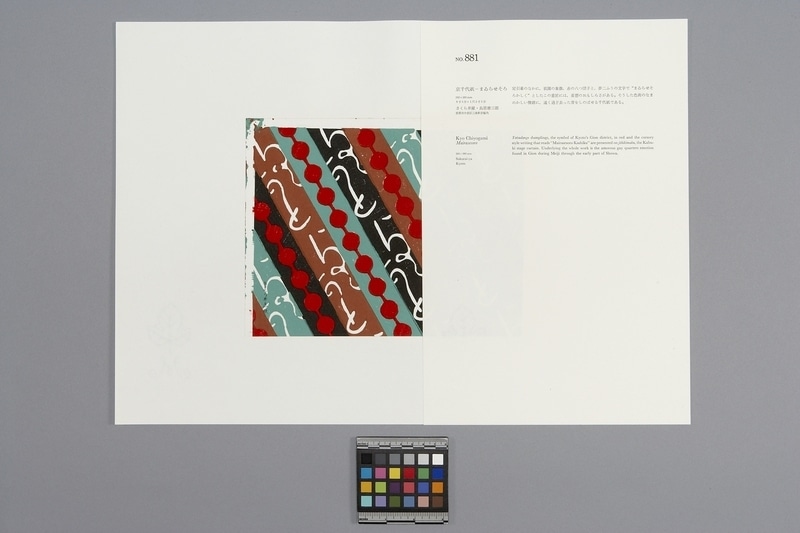Paper Item Number: Ed5.2406 from the MOA: University of British Columbia


Description
Washi sample mounted horizontally on white, labelled and folded paper with 3-pointed leaf above scrolled 'm' watermark. Rectangular multi-coloured woodblock print sample. Left to right diagonal bands. Every other band is a series of linked red circles on green, red or black alternating with white cursive script on various colours. White border on left, top and wider to right. Smudged along left side. Small vertical row of black script at bottom left on print. Mounting paper folds from right over sample.
History Of Use
Papermaking originated on the Asian mainland and spread to Japan by 1500 years ago. For centuries Japan has produced the greatest quantity and variety of handmade paper or washi in the world. Traditionally, papermaking was a family or community enterprise which thrived in mountain farming communities where cold, pure water and wild bast fibre shrubs, such as mulberry, are plentiful. Washi is an important cultural symbol and holds a place in nearly every aspect of Japanese life. It is also a significant aspect of both Shinto and Buddhist rites and customs. Chiyogami was traditionally used for writing paper, poetry paper or for lining incense boxes or for wrapping cosmetics. It is presently also used for Anesama dolls, toys, artificial flowers and greeting cards. Although formerly an expensive luxury item, used only by high-ranking individuals, chiyogami later became less expensive, and a popular gift for young women in general. This print represents the 'johikimaku' kabuki stage curtain.
Cultural Context
sample
Narrative
This is part of the Tesukiwashi Taikan, a collection of handmade paper published, in an edition of 1000 copies, in Tokyo as a project to commemorate the centennial of Mainchi Newspapers and to preserve Japanese handmade paper. A collection on this scale had not been made before. This collection consists of 5 boxes of mounted and labelled samples with an explanatory book in 4 of the boxes. The text is in Japanese and with less detail, in English. Compiled and edited by a special editorial staff of scholars. Published by the Mainchi Newspapers of Tokyo, Japan.
Item History
- Made by Sakurai-Ya (Maker) in Kyoto, Japan before 1974
- Collected during 1977
- Owned by Yoshihisa Okamatsu before March 23, 1977
- Received from Yoshihisa Okamatsu (Donor) on March 23, 1977
What
- Name
- Paper
- Identification Number
- Ed5.2406
- Type of Item
- paper
- Overall
- height 51.5 cm, width 36.5 cm
Who
- Culture
- Japanese
- Creator
- Sakurai-Ya (Maker)
- Previous Owner
- Yoshihisa Okamatsu
- Received from
- Yoshihisa Okamatsu (Donor)
Where
- Holding Institution
- MOA: University of British Columbia
- Made in
- Kyoto, Japan
When
- Creation Date
- before 1974
- Collection Date
- during 1977
- Ownership Date
- before March 23, 1977
- Acquisition Date
- on March 23, 1977
Other
- Item Classes
- works on paper
- Condition
- good
- Accession Number
- 0369/0047 pp